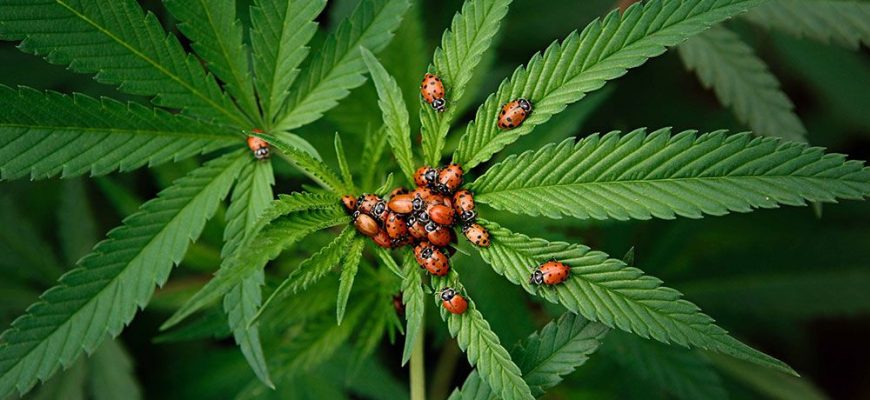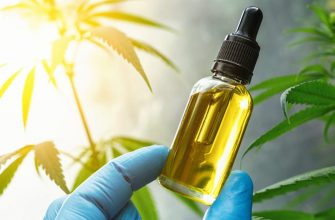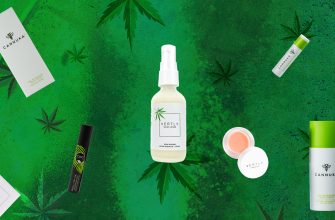When growing both outdoors and indoors, protecting marijuana from pests is the key to a good harvest. Even one small insect is able to reduce the scale of the harvest to very miserable values. We will not allow the reproduction of pests, and that is why we propose to understand their types and methods of dealing with them.
Cannabis pests – what can ruin your crop
In the natural environment, many people want to eat hemp: moles, bears, aphids, spiders, midges, mold, rot, etc. Some of them do not threaten the plant with death, but only affect the amount of the crop. However, pests such as bears and moles are able to completely exterminate the entire plantation. People have learned to deal with them in both folk and scientific ways: from using alarm clocks (moles are afraid when a loud signal sounds near a plant) to chemicals.
If outdoor pests just come from the environment, where do they come from indoors? Insects enter the greenhouse through ventilation, they are easy to bring on clothes or shoes. Rot and fungus are spread by spores. Their content in the air is simply huge. They are present in every grow room, but they manifest themselves only under certain conditions: with high humidity, lack of light and low or vice versa too high temperatures.
Cannabis Pest Types Indoors
- Spider mite. These pests feed on plant sap – they stick to the back and pull nutrients. A white dot is formed in this place. On flowering cannabis, the tick is easily recognized by the web that the insect wraps around the inflorescences and leaves. Unlike other species, the tick is able not only to deprive you of the crop, but also to destroy the whole plant. It is better to fight it with proven means – “BioProtect” or its analogues.
- Whitefly. She, like the spider mite, lays her eggs on the underside of the leaf. The white fly carries viruses, and its feces cover the leaf with a dense, shiny coating, on which fungi appear. The whitefly loves the color yellow, so in addition to insecticides, growers use yellow sticky tapes to combat it.
- Aphid. The insect sucks nutrients from the bottom of the leaf closer to the center, where it leaves white dots. A folk method of dealing with this pest is ordinary ladybugs. They will not eat all the ill-wishers, but they will not allow them to multiply to catastrophic limits. Ladybugs are convenient because they can be used many times without harming themselves: when the aphid population is reduced, simply collect the ladybugs in a jar and refrigerate. In the cold they will fall asleep. If the problem occurs again, take them out, give them a couple of days to acclimatize, and put them back in the greenhouse.
- Thrips. Adults in the last stage of development are brown or black and can fly. The larvae are whitish, translucent and very small. Thrips feed on juice and leave uneven light dots on the leaves (upon close examination, it seems that these places are covered with mucus). They are controlled with pesticides and insecticides. From natural remedies – “Nim Oil” and entomopathogenic nematodes (an aqueous suspension of roundworms that love to eat thrips).
- Powdery mildew. This is not an insect, but a fungal disease. It looks like a white coating, on which water droplets form during aging. Powdery mildew appears at high humidity, lack of hood, sudden changes in temperature. Leaves close to the ground are affected first. The mycelium rises up the stem to the inflorescences and can kill the plant. The main thing is not to start the spread of the fungus. To do this, you should monitor the climate in the greenhouse and arrange the bushes so that the leaves do not touch.
How to deal with cannabis pests indoors
There is no more proven preventive method than a simple inspection, and not superficial, but detailed.
-
Plants should be inspected immediately after planting in the ground or substrate. If you carefully monitor humidity and temperature readings, as well as follow the rules of hygiene inside the grow box, then it will be enough to inspect once a week. If you are just starting on the path of successful growing and just learning the basics of plant care, then you will have to monitor the appearance of alarming symptoms every day.
-
Inspect not only the leaves on both sides, but also the internodes, the stem and the ground. In order not to loosen the soil, just tap on the pot. The flies are frightened by this sound and fly away.
For a successful grow, it is important not to be greedy and not to use the same soil several times. Buy soil or substrate for each season and don’t use ordinary soil from the street – it definitely contains insects and their larvae.
Still, it is wiser to rely not on chance and the appetite of ladybugs, but to use professional remedies for hemp pests. Everything you need to grow marijuana can be purchased from our Coffeeshop® grow shop and shipped to anywhere in the world.





